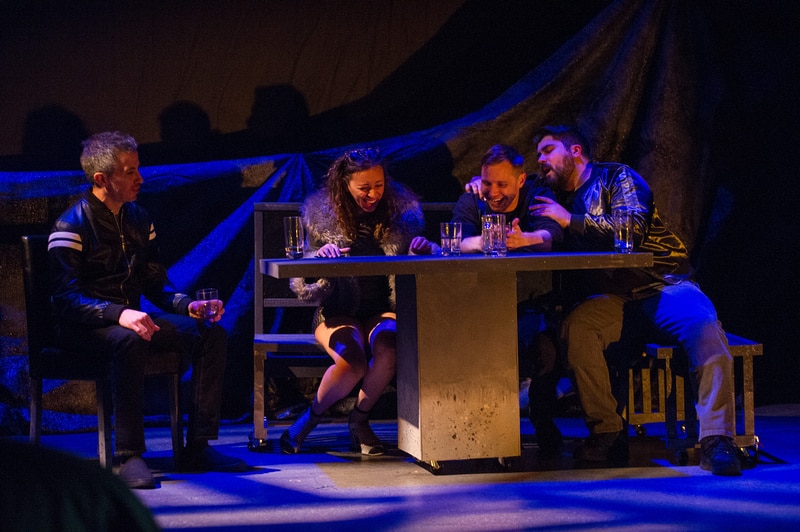The Reykjavík conjured up in Steve Yockey’s new play Reykjavík is not the family-friendly destination the Iceland tourist bureau might try to sell you. But if you’re 18 or older—and if you wish to be transported to a stunningly original world of mystery, sensuality, passion, and menace—book your passage now. Because Reykjavík is a magical trip.
The play’s point of view is that of a traveler in a very strange land. A young gay man named James, played with enchanting naivete by Josh Adams, has wanted to see the Northern Lights ever since as a child he saw them in his sister’s picture book. Something very bad happened to her, he misses her. In remembrance of her, he has come to Reykjavík—but the Aurora Borealis can’t be seen; it’s the wrong time of year; it’s all wintry and dark. Despondent, James goes to a gay disco where he is hit on by two men—Martin (Dylan Arredondo) and Grigor (Carlos Saldaña)—who get him drunk, drug him, and take him back to their room.

That first scene is played with a mix of off-kilter wit, ominous vibes, and risky sex that sets the tone for the rest of the show. The music blares so loud the dialog is inaudible, so it is projected on the back wall as subtitles (which are very funny). A woman who may or may not be named Debbie (Dina Soltan) is passed out beside James in the booth. She comes to as Martin slips under the table and gives James a blow job. There ensues the kind of spaced-out sensuality that never quite makes sense but doesn’t really need to because in the moment it just feels real.
Abruptly the upstage wall floods with an abstract animation of kaleidoscopic colors and images of ravens. Variations on this gorgeous light show (by Video Designer Kylos Brannon) will appear in between the play’s episodic scenes throughout, and the cryptic theme of birds will also recur.
What follows is a series of seemingly unrelated playlets featuring mostly homoerotic situations between characters who may or may not be real and who inhabit a conjectural space where the Huldufólk dwell—the Hidden People of Icelandic lore. It’s an improbable place where blood can fall from the sky. And it’s a world where omniscient ravens outside a hotel window can watch two men fucking then send the men messages that will unravel the lies in their love.
That scene between bird-watched lovers as played by Arredondo and Robert Bowen Smith is mindblowing. They think they know each other until they find out they don’t. We know not yet where Yockey is going with this mesmerizing play, but we might well surmise it is taking us to some very dark places.

There come subsequent scenes between men that are also sexually fraught and incrementally even more mindblowing. One is played in an eerie brothel by Arredondo as a john and Adams as his maybe-imagined trick. Another set on a street is played by Saldaña and Smith as a vacationing couple who are having an ugly/messy breakup. Yet another is played in a hotel bed in pot smoke and undies by Smith and Adams as boyfriends Peter and Ebon—the latter of whom reveals he is a brother bird to the ravens.
Several extraordinary monologues punctuate the play, among them the story Peter tells Ebon about when, as a gay boy afraid to come out, he secretly pilfered magazines and books with pictures of naked men. Smith’s delivery of the speech is exquisite.
Written less impactfully, though very well performed, is a scene between two lesbians, played by Soltan and Jenna Rossman, who meet in a Reykjavík hotel as strangers but who have actually had past lives elsewhere. Following upon the previous scenes between men, this one felt tacked on for inclusivity sake and lacked equivalent punch. Yockey’s female characters here generally get short shrift; for the most part they’re walkons—a curious omission given that Iceland ranks tops in the world for gender equality. The exception is the character Rossman appears as at the very end, in a scene that should come as a surprise. The monologue she performs then is profoundly moving.

Throughout Reykjavík, there is a dark undercurrent about sex and danger, but there is an equally strong current of longing for love and trust. Director Rick Hammerly has so beautifully modulated the two that one feels swept away—as if by magic—just as Yockey’s script would have it. The design arts play a huge part in this sensation. At the four corners of the solid gray stage, Set Designer Eric Grims stations four stele-like pillars from which Hidden People keep watch. Costume Designer Sydney Moore helps us track the multiple roles the six actors play and clothes the show in considerable wonderment and foreboding. Lighting Designer Katie McCreary and Sound Designer Thomas Sowers achieve marvelously transformative effects, sometimes literally at the snap of a finger. And Brannon’s aforementioned spectacular inter-scene video projections warrant their own exhibition in an art gallery.
Rorschach Theatre’s production of Reykjavík transcends reality in order to reveal it. Steve Yockey’s play is a phantasmagorical parable about the darkness that can underlie sexual and romantic relationships. Yet ultimately, just like James’s quest, it takes us on a splendiferous journey to see the light.
Running Time: About 85 minutes, with no intermission.
Reykjavík plays through March 3, 2019, at Rorschach Theatre performing at the Silver Spring Black Box Theatre– 8641 Colesville Road, Silver Spring, MD (next to the AFI Silver Theatre). Tickets are available online.




